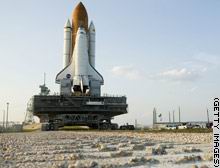NASA managers have set July 1 as the date the space shuttle Discovery will
rocket into space, the agency's first manned space flight in nearly a year.

Space Shuttle Discovery
approaches launch pad 39-B May 19 at the Kennedy Space Center in
Florida. |
The announcement came Saturday after a
two-day Flight Readiness Review at the Kennedy Space Center in Florida, where
Discovery is undergoing final preparations for launch.
Commanding the 13-day mission will be Air Force Col. Steve Lindsey, who
arrived Tuesday at the Kennedy Space Center with the other six crew members for
several days of dress rehearsals.
The shuttle will deliver supplies to the international space station and drop
off European Space Agency astronaut Thomas Reiter, who will join the Expedition
13 crew already there.
Two astronauts, Piers Sellers and Mike Fossum, will conduct two space walks
to test a new shuttle robotic arm and to repair a damaged piece of equipment
outside the ISS. If time permits, they may do a third space walk to test repair
techniques on the shuttle's thermal protection system.
NASA's decision to resume shuttle flights this summer is not without
controversy.
On NASA's return-to-flight mission last summer, the first since the Columbia
disaster in 2003, a one-pound piece of foam broke loose from the Shuttle
Discovery's external tank, just missing the orbiter.
A 1.6-pound piece of insulating foam that broke loose from Columbia's
external tank during its launch damaged the wing, an accident investigation
board concluded. The event led to the destruction of the spacecraft when
superheated gases entered the damaged wing. All seven astronauts aboard died.
After the close call with Discovery last summer, NASA managers decided to
remove the Protuberance Air Load ramp, from which the foam broke loose. The
ramp, a 40-pound wedge of insulation, is used to smooth airflow over
pressurization lines and a cable tray along the side of the tank.
Still of concern, however, are foam structures on the tank known as ice-frost
ramps, which cover the brackets that hold in place the cable tray and
pressurization lines formerly shielded by the PAL ramp.
Small pieces of foam have come off the ice-frost ramps on previous flights.
And in a worst-case scenario, small pieces of foam debris from the ice-frost
ramps could cause critical damage to the orbiter, according to wind tunnel test
results conducted by NASA this spring. Even so, NASA officials have put off
structure modifications until after the launch.